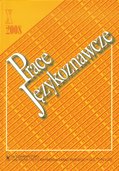Intertekstualność w nazwach escape roomów
Intertextuality in the names of escape rooms
Author(s): Ewa Oronowicz-KidaSubject(s): Studies of Literature
Published by: Wydawnictwo Uniwersytetu Warmińsko-Mazurskiego w Olsztynie
Keywords: escape room; proper name; chrematonym; onymic intertextuality; transtextualisation; intextualisation
Summary/Abstract: The subject matter of the article are the names of escape rooms (ER), with focus on theirintertextuality. First ER appeared in Poland 5 years ago and they immediately becameenormously popular, which is confirmed by the fact that this year people interested in thisnew form of entertainment have been able to visit more than 1000 mystery rooms situatedin many cities, which are diversified in terms of their size and located in different partsof the country. Because of the great interest of Polish people in ERs, which is consideredto be exeptional worldwide, they can become an inspiration for interesting diverse studies,including linguistic research. As proper names, names of ERs belong to thefield ofmarketing chrematonymy connected with human entertainment activities. Their analysisin terms of intertextuality is certainly one of the most interesting directions of research.Assuming that every proper name is a specific text, an intertext in the onymic sense relatesto a name (hypotext) in another name (hypertext). Proper names-related intertexts mayassume the form of a transtextualisation, transformation, imitation or intextualisation.In the collected linguistic material (143 names from 3 cities) there are two dominatgroupsof names. The first one consist of onyms resulting from transtextualisation, that istransfer of the name from one onymic plan to another without any formal changes, e.g.Platform 9 ¾ - a name of ER originating from a novel about Harry Potter. The second one,on the other hand, consists of names which are intextualisation in their nature, that isin the structure of which the original name occurs indirectly (e.g. it requires recognisinga given allusion) or through its with a varying degree of advancement (e.g. quotations), forinstance Perun’s Beast – a name of ERs whose narrative is set in the Slavic mythology, andPerun is a Slavic god of thunder. The form of the analysed names of ER is not surprising.For their authors the semantics of the name is more important than its structure, which isconsistent with the marketing definition of a perfect name. Thus one of the most importantobjectives of the discussed onyms is participation in competing for evry customer, whichis becoming increasingly difficult on the Polish market, and which isambodied in anattempt to make them interested and intrigued by the offered room. Apart from marketingcompetition, intertextuality of names of ERs is indirectly used for preserving the namesconnected with different cultural texts in the social memory.Intertextual names of ERs are regarded as a dynamically developing category of contemporaryproper names which require from their creators and recipients a creative andreproductive activity set in the general knowledge and culture as well as mental ctivitywhich guarantees an appropriate interpretation of new meanings hidden in the createdchrematonyms.
Journal: Prace Językoznawcze
- Issue Year: 22/2020
- Issue No: 3
- Page Range: 181-192
- Page Count: 12
- Language: Polish

